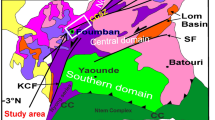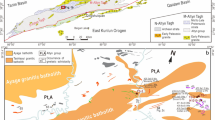Abstract
THE Seychelles Archipelago is situated in the Indian Ocean some 1,100 miles to the east of Mombasa. It is made up of nineteen islands and a number of islets of which all but two are granitic in composition. The only two coral islands in the group are Bird and Denis, which lie at a distance of about sixty miles north of Victoria, Mahé. Mahé itself is the largest of the islands, being seventeen miles long and up to seven miles wide. Rugged peaks of granite rise to a height of almost 3,000 ft. above sea-level and show marked erosion features. Praslin, Silhouette and Digue are the other main granitic islands of the group.
Similar content being viewed by others
References
Bouer, M., “Contribution to the Geology of the Seychelles, especially to the Knowledge of Laterite” (translation by the Commonwealth Bureau of Soil Science, Harpenden, Herts), Neues Jahrbuch Mineralogie Geologie und Palæontologie, 2, 163 (1898).
Poisson, M. C., C.R. Acad. Sci., Paris, (1948).
Gardiner, J. S., Nature, 73, 294 (1906).
Holmes, A., and Cahen, L., Colonial Geology and Mineral Resources, 5, No. 1, 3 (1955).
Author information
Authors and Affiliations
Rights and permissions
About this article
Cite this article
MILLER, J., MUDIE, J. Potassium-Argon Age Determinations on Granite from the Island of Mahé in the Seychelles Archipelago. Nature 192, 1174–1175 (1961). https://doi.org/10.1038/1921174a0
Issue Date:
DOI: https://doi.org/10.1038/1921174a0
- Springer Nature Limited
This article is cited by
-
Dramatic changes in leaf development of the native Capsicum chinense from the Seychelles at temperatures below 24°C
Journal of Plant Research (2009)
-
Hypothesis of Earth's Behaviour
Nature (1963)
-
Evidence from Islands on the Spreading of Ocean Floors
Nature (1963)
-
Geology and Geochronology of the Seychelles Islands and Structure of the Floor of the Arabian Sea
Nature (1963)





